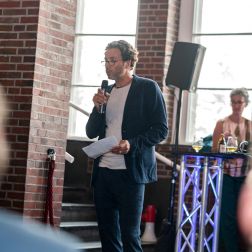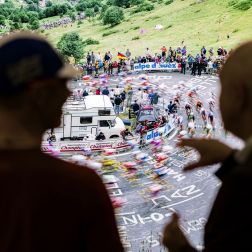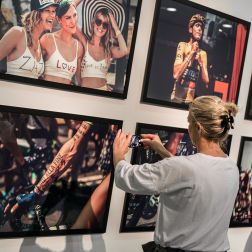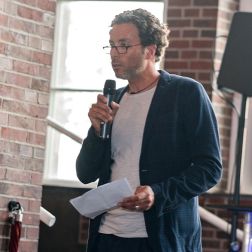Here's my speech, which I gave at the opening of the exhibition at the NRW-Forum Düsseldorf, for the pictures it's all about, it's worth visiting the exhibition "Mythos Tour de France".
Mythos Tour de France.
In my early 20's, after a motorcycle accident, I came to cycling because of my injury and have myself almost 30 years, partly very intensive but fortunately with moderate talent this sport. I know what it feels like as a rider to suffer, to have pain, to fall, to injure oneself, to get into bad weather, to have a branch of hunger.
But I also know the happiness of merging with the bike, whirring through the countryside, soaked in feelings of freedom, cranking my legs, resting my mind and under one the asphalt rushes through. Pure happiness.
In 2015 I took part in the oldest and longest bike race in the world, 1200km non-stop from Paris to Brest and back without a longer break in less than 60 hours.
I think cycling is rightly considered to be one of the hardest sports and one of the most dangerous.
Photographing this sport is as time-consuming and costly as doing it.
Photographers and professional cyclists have a lot in common:
They are impatient seekers, always looking forward, never back, speed is good for both. They are tough, have stamina and don't give up so quickly. No matter what they have achieved, there is always a new goal.
I started taking pictures of cycling when the sport was on the ground and nobody was interested in it in this country. I was constantly getting advice on what to photograph instead.
For my big La Photo picture I drove 2001 with a small Clio to alpe D`Huez, slept up on the mountain in the car sitting, in cold weather and the next day with my 8x10 inch plate camera I had only 2 cassettes with 4 exposures available.
I was rewarded for my efforts with a perfect scenery, snow behind on the mountains in front the perfect last serpentine, today there is a net, so that you don't fall down.
Years later when I started with the panoramas I slept in the car in the Pyrenees for 4 days on top of the Col du Tourmalet, this time at least a station wagon, it had rained and I was standing in the deep mud not knowing if it would ever make any sense at all.
Myths and legends are entwined around this sport also negative.
I don't want to endorse the doping offences in cycling, but I don't think it is appropriate to apply a moral yardstick to a sport that is not applied to the rest of society and other sports to the same extent.
If careers in the professional and political world are successful with deception, lies, fraud and greed, it is no wonder that the same means are used in sport.
Cycling is not a problem, it is a general social phenomenon.
We are always interested only in the winners. The spectators, the media, the sponsors. The stories of the winners are not always the most exciting, their biographies are partly interchangeable. Those who didn't win also have a lot to tell, very different stories.
If one speaks of the runner-up as the first loser, we shouldn't be surprised if every means is used to avoid being that person.
We all feel we are always one of these others, there is always at least one who is even faster, better, more beautiful, more successful. Less superlatives, less greed would do us all good.
That's why I photographed the sport and the landscape. Not the winners, but the drivers. And that's why this exhibition with its immensely high quality is dedicated to all facets of this mystical race.
I am enormously proud to be part of this exhibition in my favourite museum together with so many well-known and interesting artists.
And now there were enough words, now the pictures should tell their own stories, stories about a myth, which one gets even closer to with pictures than with words.
Thanks to Alain Bieber and the whole team, you did a great job and it was such a pleasure to work with you.






